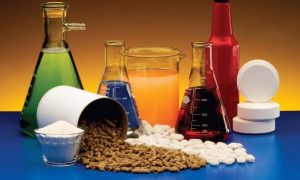
All the basic chemicals and its by-products like fertilizers, paints, varnishes, glass, perfumes, toiletries, pharmaceuticals, etc. account for an important part of the Indian economy. From the most diversified industrial sectors, chemicals cover an array of more than 70,000 commercial products. Globally, India stands on the sixth rank of being the largest producer of chemicals and the third-largest producer in Asia in terms of output. India globally ranks 3rd in the production of agrochemicals and contributes approx. 16% to the global dyestuff and dye intermediates production.
Related Projects:- Chemicals (Organic, Inorganic, Industrial) Projects
Demand of Chemicals from Different Industries
The chemical industry has seen a growth of 13 to 14 % in the last 5 years while petrochemicals have recorded a growth of 8 to 9 % over the same period. The key drivers behind India’s chemical industry are-
- Structural Advantage – With the increasing market and purchasing power, the domestic industry is supposed to grow at over 10 to 13 % in the upcoming years. Increasing disposable salaries and rising urbanization are a few reasons that are fueling the end of consumer demands for paints, textiles, adhesives, and construction. All this leads to a substantial growth opportunity for chemical companies.
- High Domestic Consumption – The industry of chemicals India is the biggest consumer of its products, consuming 33% of its output. Having a promising growth trend in the chemicals industry, internal consumption is also set to increase.
- Diversified industry – The chemical industry of India has an expanded manufacturing base that produces world-class products. There is also a substantial presence of downstream industries in every segment. Moreover, the large and extended domestic chemicals market also pushes a large pool of highly trained scientific manpower.
- Promising export potential – The chemical industry constitutes 5.4% of India’s total exports. India has a strong presence in the export market in the sub-segment of dyes, pharmaceuticals, and agrochemicals.
Related Books:- Chemical Technology (Organic, Inorganic, Industrial), Fine Chemicals
Forecasted Growth of the Chemical Industry
The chemical players of India have focused on sustainable development. Chemical industries in India are majorly investing in innovative solutions to get appropriate answers to the challenges they are facing. The total exports of chemicals that include dyes and dye intermediates, organic and inorganic chemicals, stands at the US $19.09 billion between the year 2018-2019 and stood at the US $ 15.67 billion during the year 2020 till January. The leading importers of cosmetics, toiletries, and essential oils are The US, the UAE, the UK, Bangladesh, and Saudi Arabia. From April 2019 to January 2020, dyes export increased to 9.12 % to the US $ 2.27 billion. During this period, the export of essential oils improved 22.23 % to the US $ 171.79 million, the cosmetics and toiletries increased 5.62 % to the US $ 1,444.15 million, whereas castor oil export stood at the US $ 769.05 million.
Related Videos:- Chemicals (Organic, Inorganic, Industrial)
The export of inorganic, organic, and agrochemicals stood at US $863.38 million, US $ 7.14 billion, and US $ 2.83 billion from the year April 2019 to January 2020 respectively. The chemical sector is anticipated to double to the US $300 billion by the year 2025, recording a yearly growth rate of 15 to 20 %. To accomplish it, the government is working on a draft chemical policy that will be focusing on meeting the increasing demand for chemicals and reducing imports. Total export for chemicals was at the US $ 19.09 billion during the year 2018-2019.
Conclusion
The chemical industry is huge and comprises a lot of aspects, NPCS has written a book named “Detailed Project Profiles on 9 Selected Chemical Industries (2nd Edition)” where they have combined all the important information of chemical industry that consists of project profiles of projects like copper sulfate from metallic scrap copper, hydrogen peroxide (anthraquinone autoxidation process), etc. The book has served as a useful tool for new entrepreneurs, technical institutions, existing units, and technocrats.
Noo_Art20